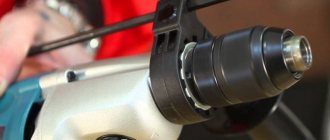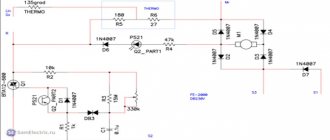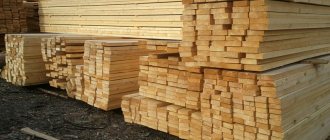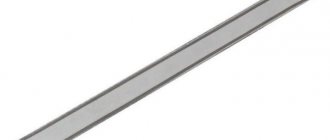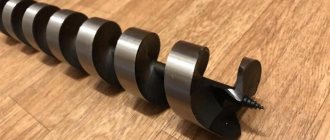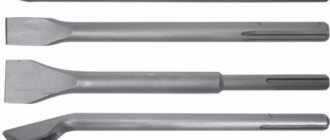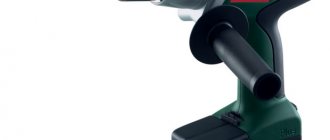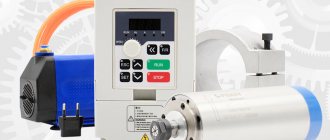The construction mixer is designed to produce homogeneous solutions from various components. The efficiency of its operation directly depends on how correctly the nozzle is selected - the auger (corolla). It is a nozzle, at one end of which there is a shank for attaching to the tool, and at the other end there are blades of various shapes. When choosing an auger, you should pay attention to the shape of the blades, shank, material and its purpose.
Types of augers by blade type
The composition of the solution, its volume and consistency require a whisk of a certain shape for mixing, so it is important to choose the right model.
1. Spiral nozzle (whisk).
This is the most common type. It is a long rod with several spiral turns and a protective ring at the end. They are right- and left-handed. In the first case, the spiral is twisted clockwise, in the second - counterclockwise.
The right-hand ones are designed for preparing thick cement and plaster mixtures. In such solutions, heavy particles settle down, and a spiral moving clockwise lifts them to the top, giving the composition a uniform consistency.
To mix substances with a low degree of viscosity: liquid putties, paints and varnishes, a left-hand whisk is required. The spiral rotates counterclockwise and lowers the solution down, preventing it from splashing.
If the mixer is equipped with a reverse function, then you can get by with one type of auger.
2. Corolla with straight blades.
It mixes the compositions only in a horizontal plane, perfectly removes existing air bubbles from them and prevents the formation of new ones. It is used to produce mixtures based on gypsum, polymer resins, sealants, and adhesives. Excess air in such materials leads to their loss of their performance properties.
3. Screw-shaped nozzle (whisk).
It is a corolla with oppositely directed blades. It is used for mixing very light liquid solutions, most often varnishes and paints. There are models with two screws on the rod. The lower one lifts the components and mixes them, the upper one presses the solution and prevents splashing.
4. For the preparation of concrete, sand-gravel mixtures, bitumen and other high-density materials, special-purpose nozzles that are particularly durable are used.
The diameter of the corolla ranges from 80 to 160 mm. The standard length of the auger is 40 and 60 cm. If it is not enough, additional rods are used. The total length of the whisk can reach up to 1 m. This auger can mix solutions in containers up to 200 liters.
Is it possible to use a hammer drill instead of a mixer?
The primary question is whether a hammer drill can be used to replace a special mixer. Actually yes.
So if you are wondering whether it is possible to use a household, semi-professional hammer drill rather than a mixer, then the answer will be positive. The device can be replaced.
At the same time, there are 2 main reasons for choosing a hammer drill.
- Technical similarities. In fact, the internal structure of a hammer drill differs little from a mixer. In both cases, the devices are powered by an electric motor. It creates torque and transmits it to the shaft where the corresponding attachment is attached. The main technical characteristics are tied precisely to the electric motor. Hence the technical similarity.
- Prevalence of hammer drills. Unlike mixers, many home craftsmen have hammer drills. They are bought for household needs and more. This is a multifunctional device. Therefore, it is quite possible to install a suitable mixing attachment on it and knead the solution.
But before you take a hammer drill and use this equipment as a mixer, it won’t hurt to compare the two units with each other.
In both cases, the tools allow you to adjust and change the speed of rotation of the engine shaft. If the tool has a universal commutator-type motor, then you can even change the speed by connecting a step-down transformer to the mains. This makes it possible to choose any suitable rotation speed. But this option is suitable only if you need to mix a solution of low viscosity. After all, following a drop in input voltage, not only the motor speed will drop, but also the torque on the shaft.
If the mixed medium is more viscous, then other options will have to be considered.
Using a nozzle with a smaller impeller diameter
If the solution is viscous, but you only have a perforator for mixing, then you can take a suitable nozzle. In this case, select the minimum length of the mixing element blade. There is a pitfall here. After all, here the diameter of the container where mixing occurs is closely related to the diameter of the mixer blade.
A certain ratio is required here. For a viscous solution this is about 1 to 2. And for more liquid ones it is 1 to 4. As a result, if you take a nozzle with a smaller blade diameter, then you will have to use a small container. This has a negative impact on performance. If you are renovating your home, then this will be enough. If this is serious construction or finishing work, this is not the best option.
Manual movement of the hammer drill
Compared to stationary and powerful mixers, a hammer drill is more mobile. By mixing the solution in a large container, you can simply start moving the tool in different directions and to the required depth. Thus, even with a small diameter of the blades on the mixer attachment, it will be possible to mix a large volume of solution of sufficiently high quality.
But the downside is that operating a rotary hammer can be physically difficult. Plus the mixing will be somewhat uneven.
Using forced cooling of a commutator motor
One of the problems with using a hammer drill instead of a mixer is that the tool's electric motor gets hot quickly. It is cooled by an air system. And the hammer drill will not be able to work for a long time in the mixing mode, especially with a thick solution. The electric motor will simply overheat and may automatically turn off. The temperature sensor will work, which will activate the overheating protection.
Air cooling is realized by a fan that rotates automatically along with the shaft. When the speed is low, that is, you are mixing a thick solution, the cooling fan also rotates slowly. Consequently, the air flow is not enough. As a result, the engine overheats. You may not have time to mix the thick mixture, and the protection will work. Until the motor cools down, you won’t be able to turn on the tool. What you should absolutely not do is turn off the sensor.
To solve the problem of overheating, you can use forced cooling for a commutator motor. It can be water or air. Thus, at low speeds the electric motor will not overheat and the productivity of the mixer hammer will increase.
Application of a rotary hammer with an asynchronous motor
Objectively, it is best to use a rotary hammer as a mixer if it is a device with an asynchronous motor.
This type of electric motor has several features:
- shaft speed parameters change not due to changes in input voltage, but depending on changes in current frequency;
- a frequency converter is used in the design of an asynchronous electric motor;
- the tool is able to maintain constant shaft speeds regardless of the load on it;
- makes it possible to mix solutions without difficulty and overheating.
But there is one drawback - the high cost of the hammer drill itself, which uses an asynchronous electric motor. Plus, some devices have a fairly delicate design. Regular and active mixing of solutions, especially thick ones, can lead to breakdowns, and eliminating them will be very expensive.
We can conclude that a hammer drill can replace a mixer. But it is still not recommended to abuse this and use the tool for such purposes on an ongoing basis.
Types of attachments by mounting method
The shape of the shank determines which tool this auger can be mounted on. Some models can only be installed on professional mixers. Other attachments are also suitable for household drills and rotary hammers. The following types of shanks are distinguished:
- standard hexagon 8.9 and 10 mm - universal type. Installed in high power mixers and drills equipped with a jaw chuck;
- hexagon 8, 10, 12 mm, equipped with a groove for spring fastening. It can be used in both HEX and clamp chucks;
- threaded shanks M 12, M 14 provide the most reliable connection, withstanding high loads and high torque. However, they are installed exclusively on professional, highly specialized mixers;
- shanks for SDS-plus chucks are attached only to high- and medium-power hammer drills;
- Morse taper is used for fastening industrial screws, providing fast, accurate centering and reliable fastening.
Does the length of the nozzle matter?
All beaters for construction mixers, drills and hammer drills have two standard lengths: 400 and 600 mm. But what if you need to mix 200 liters or more? Here extension cords that are attached to the rims come to the rescue. The maximum extension cord size that is commercially available is 1000 mm. That is, you can get a nozzle 1.4 or 1.6 m long.
Why lengthen the whisk at all? In order to reach the fragments of the mixture at the bottom and get a truly homogeneous consistency. But according to our practice, in 99% of cases, extension cords are not required for personal needs.
Equipment for working with nozzles:
- It will both drill and screw: how to choose a drill/driver?
- Drill, Shura: rating of the best corded drills 2019
Material for making nozzles
The service life of the whisk depends on its quality and operating conditions. Professional screws for working with thick mixtures and abrasive substances are made of stainless steel. They can last for several seasons. Budget models made of anodized aluminum or galvanized steel are more affordable, but are designed mainly for domestic use. Screw-shaped nozzles are made mainly of plastic, since they are not subject to significant loads.
Taking these criteria into account will help you choose the construction mixer attachments that are optimal for mixing various mixtures.
05.10.2018

